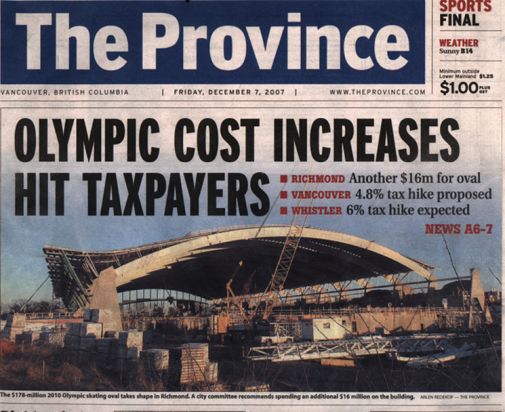Olympic venue costs continue to rise
Olympic venue costs balloon
$580-million budget will be met, VANOC maintains
Clare Ogilvie, The Province
Published: Friday, October 17, 2008
The cost of building some 2010 Olympic competition venues has ballooned by almost half, a newly-released report shows.
Originally budgeted at $212.2 million, five venues have undergone an Olympic-sized increase to $314.2 million, a 48-per-cent hike, the Vancouver Organizing Committee's annual report shows.
As an example, Whistler's Olympic Park, the Nordic venue, has risen to $122.4 million from the original estimate of $102 million.
Whistler's Sliding Centre, the venue most notorious for cost increases, is now at $106.3 million but was pegged at $55 million in the bid phase.
But Olympic organizers say that construction costs will not go above the government-funded $580-million budget and they will not be asking for more money.
"We have said all along that our budget is $580 million and it is still going to be completed for $580 million," said VANOC chief financial officer John McLaughlin yesterday.
"It really is no more money. We are not asking for any more money," he said.
The extra costs are being taken out of the construction contingency fund, which now stands at $13.7 million, down from $139 million.
That's a concern, said NDP Olympic critic Harry Bains.
"I think it is a concern that the [contingency] of $13 million may not be enough, considering that some of the major projects are still under way," he said.
He also questioned why VANOC did not include an explanation about why the venues costs have gone up.
"They haven't given an explanation and that affects public trust," Bains said.
Some of the increases arose when venues were modified after testing by athletes or support staff, said McLaughlin.
Games organizers are expecting to weather the current global financial crisis because much of the revenues are already committed by sponsors and others.
"The situation we are finding ourselves in right now is unparalleled, so trying to predict what is going to come out is hugely challenging," said McLaughlin.
"But if we look at our financial position, about 79 per cent of revenues are committed to us so far and, if you add in what we expect to get from the ticketing program, that number jumps up quite significantly."
Sponsorship revenue is expected to be $768 million.
When asked what would happen if people did not buy tickets due to drops in discretionary spending, common in recessions, McLaughlin said there was a contingency to deal with such events, though he expects tickets sales to be high.
"We do have a contingency in the budget and that is what it is meant to be dealing with," he said.
Vanoc is also confident in assurances given them by the City of Vancouver on the $60-million over-budget Athletes' Village centre.
"Our biggest concern here is that the village be there and be ready at the time when the athletes need to move in, and we are hearing that it will be so," said McLaughlin.
"That makes us feel comfortable with it. But the economy is in turbulent times so we watch it like everybody else does."
The annual report also showed a $48.1-million deficit as was predicted by VANOC earlier this year. It is due mainly, said McLaughlin, to the timing of cash flows.
"It is not indicative of the financial performance of the organization," he said.
